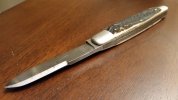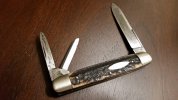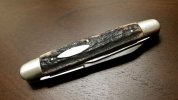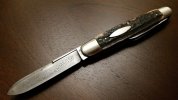Cool discussion above

- I have found a few "sleepers" - those knives essentially never sharpened & lightly used if at all and probably forgotten for one reason or another in a drawer where the conditions were right - when you see original polish lines, sharp transitions of the swedges and shine from original polish in the liner it is like hitting "gold"

....
On another note - here is a fairly different old knife to add to the thread...
Billings & Spencer Co (1869-1963) though well-known for their tools and in particular wrenches made a few knives and only between the years of 1890-1914. Three in particular were designed and patented by Charles Billings during that time frame. I was lucky enough to find one of those knives below – a Combination Sliding Knife with 3 different Screw Driver heads called a Sportsmans knife and advertised as such in a 1903 issue of Forest and Stream magazine. For those interested I thought I would share the following history most of which was from the following link to whom historical credit is given (alloy-artifacts.org) -
http://alloy-artifacts.org/billings-spencer-company.html
Historical Summary:
Billings & Spencer began in 1869 as the Roper Sporting Arms Company, a partnership of Charles E. Billings and Christopher Spencer. Both founders were notable inventors (Charles invented a Combination Bowie Knife-Pistol in 1868 which was patented), and Billings in particular was one of the pioneers of the drop forging process for hand tools and the Drop Forging machine itself. The company’s early products were drop-forgings for the arms and
sewing machine industries.
The company was reorganized as the Billings & Spencer Company in 1873 (Hartford CT), and began producing open-end wrenches and other tools shortly after this. Some products were based on designs developed and patented by Charles E. Billings, and the company also licensed designs from other inventors. Adjustable wrenches of many kinds and uses were a particular specialty during the latter part of the 19th century, By the early 20th century
Billings & Spencer had become one of the largest tool makers, in addition to being a dominant force in the drop forging industry. In the 1900s the company began to stumble from its leadership position and in 1962 Billings was acquired by the Crescent Niagara corporation, a holding company that had previously
purchased Crescent Tools.
Billings & Spencer Sliding Combination Knife - Sportsmans (1896)
B&S knives are not easy finds at all and quite rare (all made with metal knurled handles), and were made between 1890 and 1914 – my understanding is that there were only 3 patented knives – a 1896 Sliding Knife, 1896 patented combination Sliding Knife marked with 1892 & 1896 patent dates (and a variety of other combination tools as part of patent and a Butterfly Knife patented in 1908). Pure luck landed me this one. This knife was their second knife produced and was a combination sliding knife with tool accessories and advertised for sportsmen in Forest and Stream magazine in 1903 (see below attachment). It has a knurled metal handle which was indeed found on all their knives – never any other handle materials to my knowledge.
Basically the knife and tools are opened by a pin and spring mechanism that locks all into the handle. The pin is pulled up and the whole inner structure called the arm slides outside the handle where one can choose their blade. Subsequently the remaining tools are folded back inside the main structural foundation and slide back into handle where the sliding pin locks it all in place. The blade found on this knife is exactly the same found on the 1892 patented Sliding Knife. This knife is one of the variations found in the patent 554,046 – 3 screw drivers and one blade. (Link to patent:
http://www.datamp.org/patents/displayPatent.php?id=12531 ) …
Anyway something abit unique and different but probably 110-120 years old.
Thanks for looking!!
Lee
Forest and Stream Ad 1903
Almost forgot the stamp on handle:

 - I have found a few "sleepers" - those knives essentially never sharpened & lightly used if at all and probably forgotten for one reason or another in a drawer where the conditions were right - when you see original polish lines, sharp transitions of the swedges and shine from original polish in the liner it is like hitting "gold"
- I have found a few "sleepers" - those knives essentially never sharpened & lightly used if at all and probably forgotten for one reason or another in a drawer where the conditions were right - when you see original polish lines, sharp transitions of the swedges and shine from original polish in the liner it is like hitting "gold" 
















